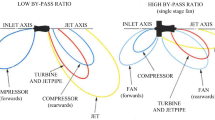Abstract
This study analyzed how the outlet and torsion angles of an oil cooler fan in large-sized diesel engines affect the performance of the fan using a numerical analysis method. The discharge flow rate, theoretical power, and efficiency were numerically calculated at the variable outlet and torsion angles. Results showed that the discharge flow rate slightly increased with increased outlet angle, leading to increased theoretical power and efficiency. The outlet-side blade also came closer to a vertical position with smaller torsion angle for higher performance of the fan. To verify the numerical analysis results, an experiment was conducted according to AMCA Standard 210–99 and the results were compared. The performance curve of the experimental and numerical analysis results indicated about 3% error.
Similar content being viewed by others
References
J. S. Park, H. S. Kim, D. J. Lee, S. Y. Jang and K. S. Han, A study on the transmission fluid flow in the main shaft of the automatic transmission, Proceeding of the 2006 KSAE Spring Annual Meeting, Korea (2006) 2427–2432.
M. A. Kluger, D. R. Fussner and B. Roethler, A performance comparison of various automatic transmission pumping systems, SAE (1996) 33–40.
J. S. Maeng, J, Y. Yoon, T, J. Ahn, J. E Yoon and D. J. Hahn, An experimental study for flow characteristics inside the rotor of a multi blade fan/scroll system, Trans. of the KSME(B), 23(5) (1999) 646–652.
J.-H. Kim, J.-H. Choi, A. Husain and K.-Y. Kim, Performance enhancement of axial fan blade through multi-objective optimization techniques, Journal of Mechanical Science and Technology, 24(10) (2010) 2059–2066.
J. Li, J. Chen and X. Chen, Aerodynamic response analysis of wind turbines, Journal of Mechanical Science and Technology, 1(25) (2011) 89–95.
C. M. Jang, S. J. Lim and S. H. Yang, Performance analysis for turbo blower according to inlet-vane angle, Journal of the KSME B, 35(3) 301–307.
K. Y. Kim and S. J. Seo, Application of numerical optimization technique to design of forward-curved blades centrifugal fan, JSME International Journal-Series B, 49(1) 152–158.
AMCA Publication 203, Field performance measurements of fan system, Air Movement and Control Association, Illinois, USA (2007).
Author information
Authors and Affiliations
Corresponding author
Additional information
Recommended by Associate Editor Byeong Rog Shin
Chung Seob Yi received his M.S. and Ph.D. degrees from the Department of Mechanical Engineering, Gyeongsang National University, Korea. After earning his Ph.D. degree, he worked as a senior researcher in Samwon Heavy Industries, Gimhe, Korea. Currently, he is immersed in post-doctoral studies in the School of Mechanical and Aerospace Engineering, Gyeongsang National University. His research interests include the heat transfer of convection and computational fluid dynamics.
Jeong Se Suh received his B.S., M.S., and Ph.D. degrees from the Department of Mechanical Engineering, Seoul National University, Korea. He is a professor in the School of Mechanical Engineering, Gyeongsang National University, Jinju, Korea. His research interests include solar heating systems, heat transfer, computational fluid dynamics, heat pipe design, and renewable energy systems.
Chul Ki Song received his B.S., M.S., and Ph.D. degrees in Mechanical Engineering from Seoul National University, Korea, in 1986, 1988, and 1996, respectively. He worked at Kia Motors Company from 1989 to 1998. Currently, he is a professor in the School of Mechanical Engineering, Gyeongsang National University, Korea.
Ji Hun Yun received his B.S. degree in Mechanical and Aerospace Engineering from Gyeongsang National University, Korea in 2011. He then received his M.S. degree from the same department of Gyeongsang National University in 2012.
In Guk Jeong received his B.S. degree in Mechanical and Aerospace Engineering from Gyeongsang National University, Korea in 2011. He is currently taking an M.S. course in the same department of Gyeongsang National University.
Rights and permissions
About this article
Cite this article
Yi, C.S., Yun, J.H., Jeong, I.G. et al. Predicting the oil cooler fan performance of large-sized diesel engines by changing the outlet and torsion angles. J Mech Sci Technol 27, 469–475 (2013). https://doi.org/10.1007/s12206-012-1244-7
Received:
Revised:
Accepted:
Published:
Issue Date:
DOI: https://doi.org/10.1007/s12206-012-1244-7




